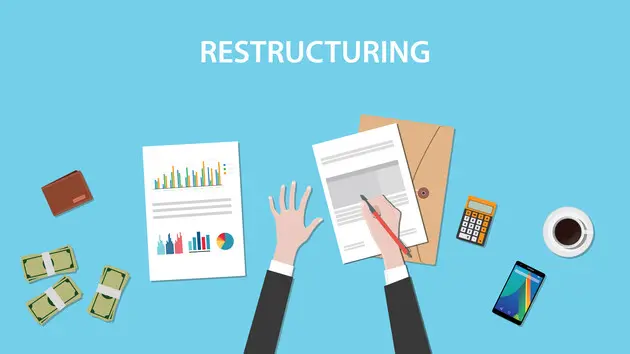Restructuring of Eurobond Debt. How to Avoid Mistakes
Negotiations with the Committee of Eurobond owners regarding the restructuring of Ukraine's 23.6 billion debt are currently ongoing. The government proposes to exchange all existing Eurobonds for a series of ordinary bonds and government derivatives or for a series of ordinary bonds. Both options provide for a nominal debt reduction of 25 to 60%. According to the first option, the derivatives should be converted into ordinary bonds in 2027 with a nominal value determined based on the amount of tax revenues and the growth rate of the real Gross Domestic Product (GDP) by that time.
According to the standard global practice of debt restructuring, the exchange of existing securities/loans for new ones with less favorable terms for the creditor compared to the original obligations is envisaged. At the same time, quotations of old securities on the secondary market usually serve as a guideline for the exchange of old obligations for new ones. For Ukraine, such quotations have not exceeded 30% of the nominal value for a long time.
The Committee of Eurobond owners of Ukraine has not yet accepted any of the options proposed by the government. Coordination and negotiations between the parties of a potential debt agreement are ongoing. At the same time, the most active debates revolve around the question of the expediency of writing off part of the debt, the amount of such writing off, and interest rates on new bonds.
In the sphere of public discussions of this event in Ukraine, some analysts, whose investment portfolios include considerable amounts of the same Eurobonds, categorically claim that the Ministry of Finance of Ukraine needs to abandon unconditional debt cancellation. And one influential parliamentarian insists on the option of postponing debt payments for 3-4 years (until August 2027 or 2028) without taking radical measures to reduce the debt burden. According to him, this option guarantees the moderation of debt payments and is supported by the International Monetary Fund (IMF) and other official creditors.
In this context, it is advisable to find out which outcome of negotiations with creditors the International Monetary Fund (IMF) is ready to support and whether the option of simply postponing payments is as safe and innocent as some participants in the discussion are trying to present.
In the 2023 the Extended Fund Facility Program (EFF), the International Monetary Fund (IMF) unequivocally requires a deep restructuring of the debt as a condition for the rapid and decisive restoration of debt sustainability and the maintenance of an adequate level of Ukraine's international reserves. In particular, the program lays down the following debt restructuring goals:
- reaching the level of public debt of 65% of the Gross Domestic Product (GDP) by 2033;
- maintaining the government's gross debt financing needs at an average level of 8% of the Gross Domestic Product (GDP) in 2028–2033;
- reducing the amount of public debt to the level of 82% of the Gross Domestic Product (GDP) by 2028 and achieving relief in external debt service payments by 1–1.8% of GDP every year.
The program with the International Monetary Fund (IMF) also requires receiving the absolute amounts of the reduction of debt payments on Eurobonds. According to this program, it is necessary to reduce these payments by 4.6 billion US dollars in 2024, by 3.2 billion in 2025, by 3.6 billion in 2026, and by 0.5 billion in the first quarter of 2027.
In addition, it is stipulated separately that the government undertakes to develop the design of the debt transaction in accordance with the goals of the program in terms of debt sustainability. The experts of the International Monetary Fund (IMF) clearly prescribed the following: "In order to successfully achieve such goals, it is necessary to apply significant discounts (haircuts) to the value of Eurobonds."
Preliminary model calculations performed by me showed that if the war continues in 2025 and under unfavorable macroeconomic dynamics, the failure to carry out the restructuring of the external debt under the conditions of its partial write-off will cause extremely dangerous dynamics of the state debt, reaching its peak level — 127.5% of the Gross Domestic Product (GDP) in 2026. This level is twice the economically safe amount of public debt for an emerging market country.
The downward dynamics of the International Monetary Fund (IMF) from March 2024 paint an even more gloomy picture: without deep restructuring of the external debt, the total public debt of Ukraine will reach 135.7% of the Gross Domestic Product (GDP) at the end of 2026 and 134.3% of the Gross Domestic Product (GDP) at the end of 2027.
A comprehensive analysis of debt sustainability conducted by me also suggests that achieving a sustainable level of debt in 2029 (and not in 2033, as written in the scenario of the International Monetary Fund (IMF)) would require the government to receive adequate amounts of official financing with a share of grants of more than 50%. In addition, it is worth noting that in order to achieve a sustainable level of debt in 2029, it is also necessary to restructure external debt to commercial and bilateral official creditors with a reduction of its nominal amount by 60%.
If, in the process of negotiations, the government makes concessions to creditors and refuses to write off a significant part of the debt for Eurobonds, then Ukraine's debt problems will simply be preserved, and after the expiration of the received deferrals, a new restructuring will be needed. It should not be forgotten that interest is charged for the period of postponement, which is too high for a state that is conducting military operations.
A mild restructuring of Ukraine's public debt during the war would also contradict the lessons of international experience and the regularities of the debt settlement process during geopolitical shocks. Well-known scientists K. Luckner, D. Meyer, K. Reinhart and K. Trebesh summarized data on 321 cases of restructuring of external sovereign debts to private creditors in the period 1815–2020.
They found that creditor losses from debt restructurings were surprisingly stable over 200 years. In the studied sample, the average discount (haircut) was 45% in terms of net present value of debt payments. When narrowing down the studied sample to the period 1998–2020, covering debts only for bond loans, the average discount in terms of current value was again 45%, and the median discount was 42%.
In the context of Ukraine's problems, the following result of the cited study deserves attention: geopolitical upheavals, such as wars, revolutions, and the collapse of empires, are usually accompanied by greater write-offs of foreign debts and cause greater losses to creditors. Throughout history, there have been several cases of complete debt cancellation (or achieving a 100 percent discount). In general, during wars and revolutions, the average discount during restructuring increases by 20 percentage points and reaches 60%.
The most unfavorable cases of external debt restructuring for commercial creditors are shown in the table.
Restructuring of external debts during wars, revolutions, and collapses of empires in 1815–2023 with the greatest losses to creditors
|
Country |
Type of shock |
Period of default (restructuring), years |
Discount percentage (haircut) to the face value of the debt |
Amount of restructured (rejected) debt, million dollars |
|
Spain |
External intervention |
1823–1833 |
100 |
2 440 |
|
Portugal |
External intervention |
1834 |
100 |
н.д. |
|
Mexico |
External intervention |
1865 |
100 |
н.д. |
|
Dominican Republic |
Civil War |
1872 |
100 |
137 |
|
Russia |
Revolution |
1917 |
100 |
23 892 |
|
China |
Revolution |
1938 |
100 |
4 109 |
|
Lithuania |
External annexation |
1940 |
100 |
180 |
|
Latvia |
External annexation |
1940 |
100 |
109 |
|
Cuba |
Revolution |
1960 |
100 |
299 |
|
Ottoman Empire |
The collapse of the empire |
1915–1928 |
100 |
6 304 |
|
Romania |
External intervention |
1933–1959 |
98 |
1 170 |
|
Yugoslavia |
External intervention |
1932–1967 |
98 |
924 |
|
Liberia |
Multiple shocks |
1980–2009 |
97 |
1 278 |
|
Yemen |
Multiple shocks |
1983–2001 |
97 |
725 |
|
Nicaragua |
Revolution |
1979–2007 |
96 |
1 438 |
|
Peru |
War |
1931–1947 |
95 |
645 |
|
Turkey |
Disintegration and war |
1944 |
95 |
9 293 |
Source: С. Luckner, J. Meyer, C. Reinhart, Ch. Trebesch Sovereign haircuts: 200 years of creditor losses.
Another study of the International Monetary Fund (IMF) covering the period 1950-2010 listed the countries that received the largest discounts in terms of the present value of debt payments during restructurings, including debts to official creditors. This is Ivory Coast — 55.2% off; Seychelles — 56.2; Moldova — 56.3; Ecuador — 67.7; Serbia and Montenegro — 70.9; Argentina — 76.8; Iraq — 89.4%.
Finally, I would like to warn the participants of the negotiation process regarding the Ukrainian debt against the incorrect application of discount rates when generating the net present value (NPV) of debt payments. It is the net present value (NPV) indicators, as a rule, that are of key importance for assessing the discount or debt write-off percentage in the process of its restructuring.
The already mentioned financial analyst convinces us that the market discount rate should be close to 15% per annum in dollars, the same as the dollar bonds of Myronivskyi Hliboprodukt PrJSC or Metinvest LLC. But it is not clear why the market yield of corporate loans during martial law should be a reference for assessing the future value of dollar resources for the government of Ukraine.
Thus, external official loans are raised by the government of Ukraine at rates of 2–3% per annum (except for the loan of the International Monetary Fund (IMF), which costs about 8% per annum). The current yield of foreign currency loans on the domestic market (Dollar bonds of the domestic government loan) is 4.65% per annum. And the latest analysis of Ukraine's debt sustainability by the International Monetary Fund (IMF) includes indicators of the effective interest rate on public debt even within the pessimistic scenario at the level of 5.1–5.8% in 2026–2030.
The Debt Sustainability Framework (DSF) for low-income countries, developed by the International Monetary Fund (IMF) specialists, uses a discount rate of 5% for current value estimates.
In view of this, when calculating the net present value of the flow of payments for new debt obligations of Ukraine, it would be appropriate to focus on the annual discount rate of 5–6%.
It is also important to complete the restructuring of the Eurobond debt before the end of the moratorium on debt payments in August 2024. Currently, financial circles are seriously discussing the option of "interim" or "moderate" restructuring of Ukraine's debt in the form of a new deferral for debt servicing and repayment.
However, it is in the interests of the Ukrainian state not to preserve the debt problem for years through the issuance of new deferrals, but to reach an agreement with creditors in the near future on a deep restructuring of the debt with a reduction of its absolute amount. Otherwise, the debt burden on the public finance system of Ukraine will continue to grow, and it will be much more difficult to obtain concessions from creditors after the end of the war. Such a state of affairs will permanently keep our state on the edge of the financial abyss and prevent the attraction of long-term productive capital for the purpose of restoring and modernizing the national economy.
Please select it with the mouse and press Ctrl+Enter or Submit a bug
















 Login with Google
Login with Google